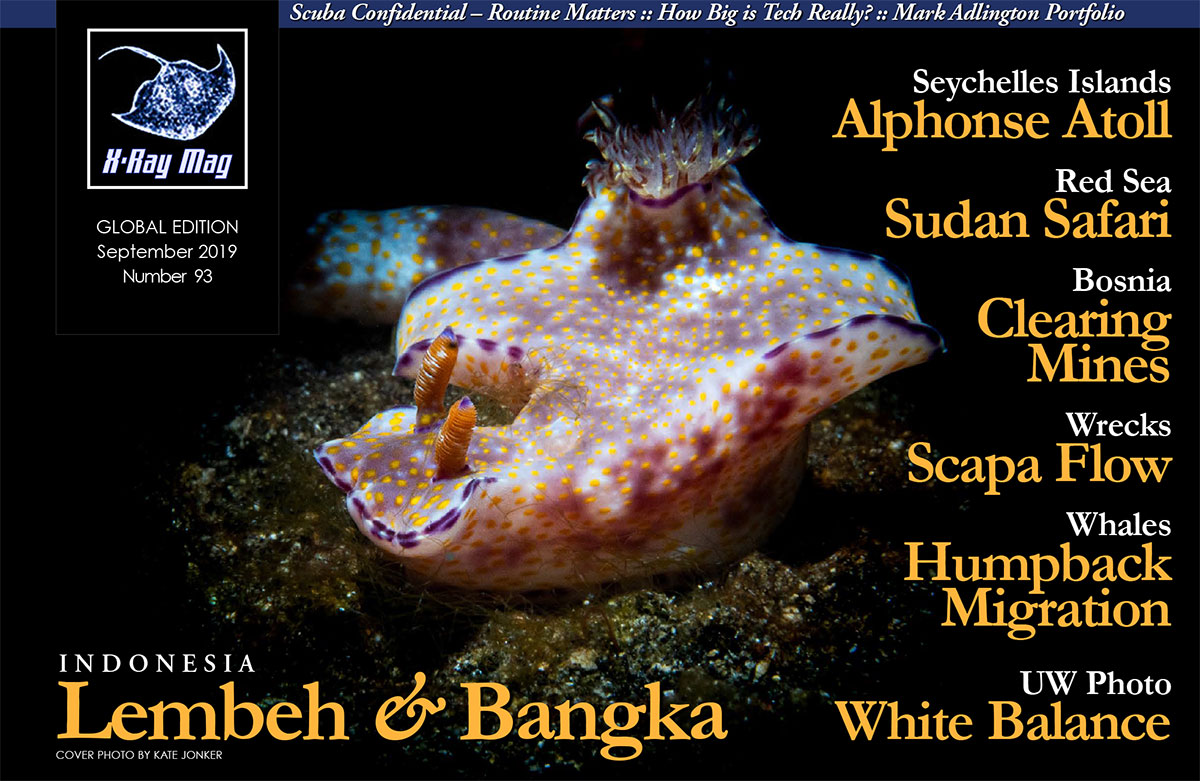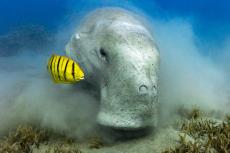From all over the world, more and more divers are coming to the Red Sea to discover its underwater paradise. The vast majority choose the Egyptian Red Sea as their main destination because it offers a wide variety of dive sites, suitable for all levels of diving; it is where one can travel all year round at a great price.
But there is another Red Sea, one that has been nearly kept in a time capsule, practically intact, unexplored and retaining a sense of adventure that the Egyptian Red Sea offered 30 years ago. We’re talking about the Sudanese Red Sea—the wild Red Sea!
Contributed by
Factfile
Blue Force Fleet, with more than 20 years of experience in the Red Sea, operates in Sudan with its new spectacular liveaboard boat, the Red Sea Blue Force 3, which was launched in November 2018. It offers 7-, 10- and 11-day cruises on all Sudanese routes from February to May.
For more information about the routes, schedules and the liveaboard boat, please go to: blueforcefleet.com.
When travelling to a place full of history, who hasn’t stopped to think about what it might have been like many years ago—trying to imagine each age, every change and interaction, and their effects on the present day? This is what I describe when someone asks me about Sudan.
Sudan was the largest country in Africa until 2011. After long years of conflict, it was divided into North Sudan and South Sudan. North Sudan, which is officially known as the Republic of Sudan, has 853km of coastline along the Red Sea. For the past 25 years, it has been immersed in internal struggles, civil rivalries and ethnic conflicts, which have completely impeded tourism and infrastructure development.
For many years, divers have wanted to dive in Sudan, but due to the lack of reliable operation of flights and boats there were drawbacks to planning a trip to the country. Since 2016, some airlines have made it easier to fly to Port Sudan, where divers can embark on liveaboards. Thanks to this, Blue Force Fleet—a company with more than 20 years of experience in dive safaris on the Red Sea—has moved to the waters of the Sudanese Red Sea, with one of the most modern and well-appointed dive boats in the area, the new Red Sea Blue Force 3. This liveaboard provides divers with opportunities to dive the best and most remote reefs in Sudanese waters, with the guaranteed service of a reliable and experienced operator.
Shark diving expedition
Due to weather conditions, Sudan has a relatively short dive season. Temperatures during the summer are very high, both above and below the waves—often reaching 30°C underwater. The high temperatures prompt large pelagics such as sharks to range at deeper depths, out of reach of recreational divers. This is why the season with the best conditions for shark sightings is limited to the months with the lowest water temperatures—January to May—when the water reaches 24 to 26°C.
In addition to sharks, the other great dive attraction in the Sudanese Red Sea is its spectacular reefs, with extensive colonies of various corals, extending from the depths up to the surface. These reefs are found in the open sea, far from the coast, so they are ideal places for marine life to shelter from predators, which, in turn, go to these places in search of prey. It is a perfect formula: a scenario of trophic equilibrium, which guarantees encounters with large groups of fish of different species and their natural predators. Together with the nearly nonexistent commercial exploitation of these places, these reefs truly are an underwater paradise.
Two main areas have been defined by diving routes, designed by the Blue Force Fleet for its Sudan Shark Dive Expedition—the Sudan “Central and North” and the Sudan “Extreme South.”
Sudan Central and North
The Central and North route is the classic and best-known route. It includes the central reefs and the upper part of the southern Red Sea. Here, one can dive the impressive wreck of the Italian ship SS Umbria. It is one of the best WWII wrecks that can be visited even by snorkelers. Resting at a shallow depth, it is full of ammunition and war supplies.
In addition, divers get the opportunity to dive on the remains of the underwater laboratory Precontinent II in Shaab Rumi, which Jacques-Yves Cousteau built in 1963. It comprises a set of submerged structures in which eight people can live continuously for up to a month, at a depth of about 10m, in the attempt to prove the viability of human life under the sea.
The rest of the dives on the Central and North route are usually carried out on the northernmost reefs of the Shaab Rumi Reef. These dive sites are full of life, large shoals of fish, incredible hard and soft corals and, of course, the ubiquitous sharks. It is difficult to describe the amount of life one can see on these dives—you have to be here to understand it.
Another notable reef along the Central and North route includes the triangle of Shambaia, where the following dive sites stand out:
Angarosh. Translated from Arabic, angarosh means “mother of sharks.” At this site, the reef is visible at the surface with a beautiful island created by coral remains. Along its reef walls and plateaus, one can see grey reef sharks, hammerhead sharks and spectacular schools of jacks. It is one of the most exciting dives of the Central and North route.
Merlo. Diving on the pinnacle at this dive site always reminds me of the best thilas, or underwater islands, in the Maldives. The light, the amount of life, the colours and the shallowness of the main pinnacle makes it a compulsory dive.
Abington. This is another coral needle dive site, which blossoms from the abyss and fills the whole area with life. Its terraces and walls turn the reef into an ecosystem where one can see large tunas, schools of jacks and, of course, sharks.
Sudan South and Extreme South
This route visits more wild and unexplored reefs, and also more remote sites, so it is usually done on longer trips. These reefs still retain large populations of different species of sharks.
In the southern reefs, the following dive sites stand out:
Sha’ab Jumna. This site is located on the northernmost reef of the Suakin. A towering coral island, marked with a small lighthouse, is one of the best dives in the area. Here, it is easy to spot hammerhead sharks, grey reef sharks, whitetip sharks and occasionally silvertip sharks.
Sha’ab Ambar. This is a huge reef, more than five miles long. It offers an inner lagoon, which provides shelter for dive boats. In the southern part of the reef, there is a sandy plateau at 25m, which is ideal for encounters with hammerhead sharks, grey reef sharks and numerous jacks.
Pinnacle. This pinnacle-shaped reef ascends from the depths, offering a rich and varied concentration of reef fish in the areas most influenced by currents. There are frequent encounters with hammerhead, grey, silver, silky and even thresher sharks.
Protector. This is a two-mile-long reef, which surrounds a large lagoon. Its southern face offers coral-filled dives and abundant reef life. In the deep waters of the outer wall of the southern tip, it is easy to find hammerhead sharks, silky sharks and sometimes oceanic manta rays.
Logan. The northern face of this dive site is the side that offers the greatest chance of encounters with hammerhead, silky, whitetip and grey reef sharks as well as large concentrations of humphead parrotfish. Occasionally, manta rays can also be found here. The eastern and western sides of the reef harbour a wide variety of corals and sea fans.
Masamirit Island. This site has a vertical wall on its eastern side and a plateau on its northern end at 25-30m, with several coral colonies where one can observe pelagic species patrolling the waters. Here, it is easy to find groups of dolphins, schools of barracudas and hammerhead sharks.
Dahrat Qab. Located 14 miles south of Masamirit, this dive site has a diverse coral reef with a wide variety of soft corals and huge sea fans. The southern tip of the reef is the most interesting point, where one can see grey reef sharks, silvertip sharks, hammerhead sharks and occasionally even a tiger shark.
Qab Miyum. Located south of Masamirit, this site presents a staggered wall of coral plateaus at 6m, 25m and 45m at its southern point. These areas allow one to observe large shoals of jackfish and barracudas passing through the area, as well as the hammerhead sharks that usually patrol the wall limits.
Dahrat Abid. This dive site is located at the southernmost islet of Sudanese waters. At the top of the reef are the remains of a wreck, and there is abundant life. The shallowest waters of the reef are covered in soft corals, and in deeper waters, various pelagics and sharks are the great attractions. ■















































